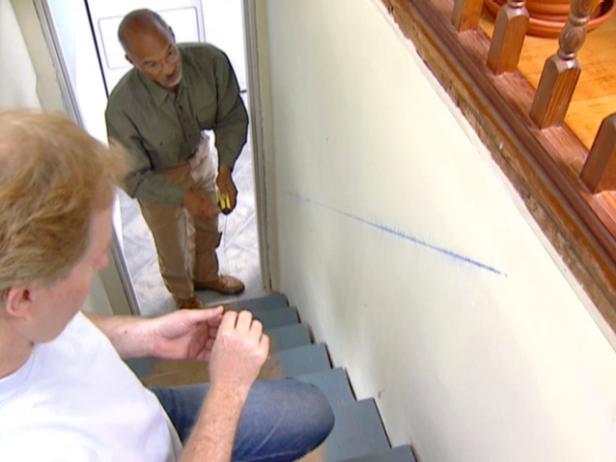Navigating staircases in your home or public spaces should be a reassuring experience, not one filled with uncertainty and fear. Loose handrails can pose significant safety hazards, hindering mobility and threatening stability. Whether you’re a homeowner tackling a DIY project or a landlord responsible for maintaining the well-being of tenants, this comprehensive guide will equip you with the knowledge and techniques to securely fasten loose handrails to the wall, restoring confidence and peace of mind.

Image: www.pinterest.es
Handrails, an indispensable component of any staircase, play a vital role in ensuring the safety and stability of individuals using them. They provide a firm and secure grip, aiding in maintaining balance, especially while ascending or descending stairs. However, over time, due to various factors such as wear and tear, improper installation, or shifts in the structure of the building, handrails can become loose. A loose handrail not only undermines its intended purpose of providing support but also transforms into a potential hazard, increasing the risk of falls and injuries.
Identifying the Root Cause: A Diagnostic Approach
Before embarking on the task of fixing a loose handrail, it is imperative to identify the underlying cause to ensure effective and long-lasting repairs. Here are several common culprits to consider:
- Inadequate Installation: Improper installation is a significant contributor to loose handrails. When handrails are not securely fastened to the wall studs or if the fasteners used are insufficient, they are more likely to loosen over time.
- Wear and Tear: Constant use and aging can cause deterioration of the fasteners or the handrail itself, resulting in a gradual loss of stability and eventual loosening.
- Structural Shifts: Fluctuations in humidity, temperature changes, or even settling of the building can exert stress on the handrails, weakening their connection to the wall.
- Poor Maintenance: Lack of regular maintenance, such as periodic inspections and tightening of fasteners, can accelerate the loosening process.
Tools and Materials: Essential Armaments for a Successful Repair
To execute the repair effectively, it is crucial to gather the necessary tools and materials. Here’s a comprehensive checklist to ensure you have everything you need:
- Screwdriver (Phillips head): Essential for tightening loose screws.
- Drill: Utilized for creating pilot holes and driving in new screws.
- Wrench: Employed to tighten nuts and bolts.
- Screws: Select screws that are long enough to penetrate the wall studs.
- Washers: Optional, but recommended to distribute pressure and prevent the screws from pulling through the handrail.
- Wood glue: Can be used to reinforce the connection between the handrail and the wall.
Step-by-Step Guide: A Blueprint for Restoration
With the necessary tools and materials at hand, follow these detailed steps to securely fix a loose handrail to the wall:

Image: www.diynetwork.com
1. Safety First: A Paramount Precaution
Before commencing any work, prioritize your safety by wearing appropriate protective gear, such as safety glasses and gloves. Additionally, ensure the stability of the staircase by securing it with a barrier or rope to prevent accidental falls.
2. Discerning the Fastener Type: Screw or Bolt?
Determine the type of fastener currently securing the handrail to the wall. It could be either screws or bolts. This information will guide your choice of tools.
3. Tightening Loose Screws: A Simple Solution
If the handrail is attached with screws, use a screwdriver to tighten them. Ensure the screws are driven securely into the wall studs by applying ample torque. Avoid overtightening, as this could strip the screws or damage the wall.
4. Replacing Worn-Out Screws: A Fresh Start
If the existing screws are damaged or stripped, replace them with new ones of the same size and type. Pre-drill pilot holes for the new screws to prevent splitting the wood.
5. The Power of Bolts: Enhanced Stability
For handrails fastened with bolts, begin by tightening the nuts with a wrench. If the bolts are loose or damaged, replace them with new ones. Remember to use washers to distribute the pressure and prevent pull-through.
6. Reinforcing the Connection: Adhesive Assistance
For added reinforcement, apply a generous amount of wood glue between the handrail and the wall before securing the fasteners. The glue will enhance the bond and provide additional stability.
7. Aesthetic Enhancement: Concealing Fasteners
To conceal the fasteners and maintain a clean appearance, fill any exposed screw or bolt heads with wood putty or caulk. Allow the filler to dry completely and sand it flush with the surface for a seamless finish.
How To Fix Loose Handrail To Wall
Conclusion: Restoring Safety and Confidence
By following the steps outlined in this comprehensive guide, you can effectively fix a loose handrail to the wall, restoring safety, stability, and peace of mind. Remember, regular maintenance is crucial to prevent future loosening and ensure the enduring reliability of the handrail. Nevertheless, if you encounter any significant structural damage or if the handrail remains loose despite your efforts, do not hesitate to seek professional assistance from a qualified contractor.